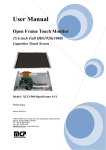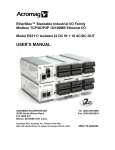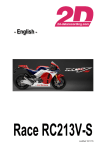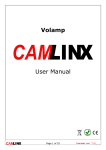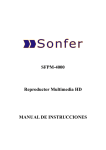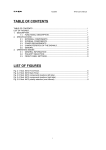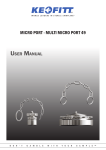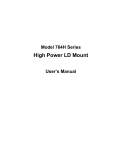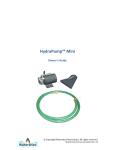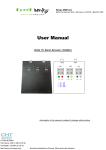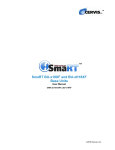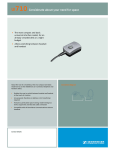Download MatchBox laser series. User manual.
Transcript
CONTENTS 1 1.1 1.2 1.3 2 2.1 2.2 2.3 2.4 2.5 2.6 3 4 4.1 4.2 4.3 4.4 5 5.1 5.2 INTRODUCTION ............................................... ... 3 SYMBOLS AND LABELS................................. ... 4 SAFETY .............................................................. ... 5 Optical Safety................................................. ... 5 Electrical safety .............................................. ... 7 Electromagnetic compatibility ....................... ... 8 DESCRIPTION AND SPECIFICATIONS ......... ... 9 Laser Output Specifications ........................... ... 9 Mechanical Design......................................... ... 9 Heat Management .......................................... ... 10 Laser Output Options ..................................... ... 11 Line-width Options ........................................ ... 15 Operating Environment .................................. ... 15 UNPACKING ...................................................... ... 17 OPERATION....................................................... ... 20 Attachment to a Heatsink ............................... ... 20 Power and Signal Connections....................... ... 20 Modulation ..................................................... ... 22 Attaching Control Interfaces .......................... ... 23 ACCESSORIES................................................... ... 25 ‘Starter’ attachment (part number: AM-C1) .. ... 25 Adapter to M6 (part number: AM-H2) .......... ... 26 5.3 Air-cooled pad (part number: AM-H1).......... ... 27 Integrated Optics INTRODUCTION The ‘MachBox’ series includes a range of continuous wave laser sources, featuring wide range of wavelength, average power and line-width options. The series is composed of solid state (DPSS) lasers as well as direct laser diode (LD) lasers. However, despite the different technical implementation, physical and electrical properties, usability and connectivity are almost identical throughout the series. Therefore Integrated Optics, UAB provides a single user manual for the entire series and emphasis on differences between models is provided wherever necessary. As the title hints, MachBox products are ultra-compact, single-unit laser sources with overall dimensions comparable to a regular matchbox (30x50x18 mm, not taking into account the fastening protrusions). Please take your time to read this instruction manual which provides essential information on the usage of the laser. We have also included various hints and tips that will help you get most from a certain laser source. 3 MatchBox series | User Manual SYMBOLS AND LABELS Along the text you will find icons designed to draw your attention to different bits of safety or otherwise important information: This icon draws your attention to important information, related to the usage of a laser. This symbol is a warning sign. It marks safety precautions ralated to optical laser radiation and alerts the operator to the danger of exposure to hazardous visible or invisible laser radiation. This symbol is a warning sign. It marks safety precautions related to electrical safety and alerts the operator to the presence of dangerous voltage, which might appear on certain conditions. Electric shocks caused by such voltage may constitute risk both to the operator and equipment used. 4 Integrated Optics 1. SAFETY 1.1: Optical Safety Light, emitted from a laser source features hazardous properties, as compared to conventional light sources, such as luminescent bulbs, light emitting diodes, etc. It is important for users, who use a laser system, or other persons approaching to it, to know the dangers involved. Only users, who are familiar with laser safety should use the laser system to minimize the risks of laser radiation-related accidents. MATCHBOX lasers are Class 3B laser products. Different models are arranged to emit up to 500 mW of visible or invisible (infrared) radiation. The radiation is hazardous if the eye is exposed directly to the beam or to specular reflection thereof. The risk of permanent eye damage or even blindness increases with longer exposure times. Diffuse reflections as those from paper or other matte surfaces are typically not harmful if viewed at a distance of 1 m (3 ft) or larger. The use of eye protection when operating the MATCHBOX laser is necessary if at any circumstances the laser beam could be exposed to eye directly or through a specular reflection. 5 MatchBox series | User Manual Eye protection in the form of spectacles or goggles with appropriate wavelength filtering is preferred. For example, eyewear absorbing in the spectral region 190 to 534 nm are suitable for working with e.g. 457 nm, 473 nm, 488 nm, 491 nm, 500 nm, 515 nm and 532 nm MATCHBOX lasers, but probably will not suit 561 nm, 593 nm or radiation of the red and infrared regions. Use of protection eyewear provides another significant advantage - when working in dark rooms, laser radiation may haze your eyes even if observed from diffuse reflections. Properly chosen eyewear will reduce or even eliminate such haze and extend productive hours. The beam emitted from Class 3B lasers can easily damage photosensitive surfaces like those found in photodiodes, CCD cameras or photomultipliers. It is important to make sure that an unattenuated beam does not strike any of aforementioned devices directly. Calculation of allowable fluence is necessary before using such devices with our lasers. In addition to laser safety from the laser source alone, following safety precautions must be followed: • Experimental setups must ALWAYS be horizontal and below eye level; 6 Integrated Optics • To avoid accidental exposure, never bend over or sight down. If something falls down from experimental setup, user must first turn off laser and just then pick up; • Use protective shields or filters to get rid of unnecessary reflections and scattering; • User should never wear jewels, watches while using the laser system to avoid the reflections from surfaces thereof; • The laser system must be used in a closed room, because high power and collimated laser beam can damage biological tissues even at long distances; • Extreme caution must be taken when using volatile substances in laser operational area; • High level of ambient light in laser operating room should be maintained whenever possible, in order to keep the pupil of the eye as small as possible and to prevent the risk of eye damage; • Warning signs must be posted near the entrance to the laser operation area and inside; • Use of laser must be limited to users, who are completely familiar with the rules above. 1.2: Electrical safety 7 MatchBox series | User Manual Electrical safety is as important as optical safety. Electric shocks from an unsuitable or poorly grounded power supply, can cause extreme pain, severe burns, cardiac arrest and can even be lethal, that is why the operator should always obey the safety measures below. User must make sure that the power supply used with MATCHBOX laser has grounded pin connection (preferably a medical type power supply) and is well grounded and that there are no grounding interruptions with other devices, because it can be dangerous for the operator and cause malfunction of the laser. 1.3: Electromagnetic compatibility The European requirements for Electromagnetic Compatibility (EMC) are specified in the EMC Directive (published in 2004/108/EC). Conformance (EMC) is achieved through compliance with the harmonized standards EN55011:2009 for emission and EN61000-6-1:2007 for immunity. The laser meets the emission requirements for Class 3B as specified in EN55011:2009. Compliance of lasers within the MATCHBOX series with the (EMC) requirements is certified by the CE mark. 8 Integrated Optics 2. DESCRIPTION AND SPECIFICATIONS 2.1: Laser Output Specifications The MATCHBOX series includes a variety of lasers featuring different wavelength and power ratings. the complete specification of the laser radiation are provided together with a certain laser, which is sold to the Buyer. A detailed specsheet incorporates output power, longterm and short term noise, line-width, beam quality and much more specifications. 2.2: Mechanical Design The laser sources within the MATCHBOX series employ a single-box design, which means that all optics, power electronics and thermal management components are located within a single enclosure. The overall dimensions of the laser are 45x50x18 mm (WxDxH), not taking into account the flexible PCB ribbon, which is used for connecting the laser to a power source and control interface, as well as different output options, such as free-space output with or without a mechanical shutter, SMA fiber port or permanently fixed fiber output. 9 MatchBox series | User Manual Figure 2-1. Front view drawing of the MATCHBOX laser. Figure 2-2. Side view drawing of the MATCHBOX laser. 2.3: Heat Management The enclosure is made from a nickel-plated copper, which ensures superior heat dissipation through the 10 Integrated Optics sides and the bottom of the enclosure. The main direction for heat dissipation is through the bottom, therefore the enclosure is preferably fitted on an additional heatsink for proper thermal management. A thermo-electric cooler (TEC) is equipped inside the enclosure for thermal management of a pump laser diode, optics and power electronics. Thermal stabilization of all critical components is very important for low-noise and efficient operation of the complete laser. Depending on laser configuration, cooling of 10 to 15 W (at 25 °C ambient temperature) may be required in a form of conduction-cooled or water-cooled heatsink, attachable to the bottom side of the laser. For efficient cooling, make sure that there are no other heat radiating devices, such as heat exchangers, heaters or computers in the proximity of the laser. For efficient cooling, make sure that the laser is not covered with or obstructed by any obstacles, which could prevent air circulation around the laser. 2.4: Laser Output Options MATCHBOX laser sources are offered in three main configurations with respect to the output of laser radiation. 11 MatchBox series | User Manual Free-space output is commonly employed in compact (portable) laser devices, where working place (an object to be irradiated) is relatively close to the laser source and the beam could be delivered directly or using just few mirrors. Furthermore, the free-space output versions could be equipped with mechanical safety shutter (not shown in pictures), which might be necessary for scientific openframe setups. The mechanical shutter must be shut whenever the laser is not in operation or it could be shut for a short period of time, whenever minor adjustments need to be made without stopping the laser, thus stable operation is not lost. Figure 2-3. Free-space output version of the MATCHBOX laser. 12 Integrated Optics SMA fiber port output is particularly convenient in setups, where the laser has to be switched from one source to another without changing anything else in the setup. This is often the case in metrology or in fluorescence or Raman spectroscopy systems when radiation wavelengths are changed by switching to another laser source. This form of laser output can be used only with multimode fibers as the SMA connector features some tiny loose space between the ferule and the interior of the connector as well as repeatability of the fiber attachment features poor repeatability. Figure 2-4. SMA port output version of the MATCHBOX laser. 13 MatchBox series | User Manual Permanent fiber pigtailed output has few modifications, though it looks essentially the same. The difference is in the fiber type. Multi-mode, single-mode or single-mode polarization maintaining fiber could be arranged within this output type. It is readily used in microscopy and diagnostic setups, where few laser sources are placed in a distance from the analytical device, e.g. a microscope, and radiation of several wavelengths is delivered to the microscope via optical fibers. Lasers with non-detachable fibers usually feature higher fiber coupling efficiency, as compared to SMA port output, thus more optical power is useful. Figure 2-5. Fiber pigtailed output version of the MATCHBOX laser. 14 Integrated Optics 2.5: Line-width Options Almost all MATCHBOX lasers are offered in two linewidth options - broad and narrow, in other words, respectively featuring multiple longitudinal modes or single-longitudinal mode (SLM). In all cases, the broad line-width option means, that no additional measures were taken to narrow the emission spectra - it is as radiated by a laser diode (in direct diode lasers) or a gain medium (in DPSS lasers). The narrow line-width option means that special measures were taken to force radiation of just single longitudinal mode (SLM in DPSS lasers) or stabilized wavelength and one or just few longitudinal modes (in direct diode lasers). Usually, the SLM version of DPSS MATCHBOX lasers feature line-width of >0,5 pm or the bandwidth is >15 MHz. 2.6: Operating Environment MATCHBOX lasers are designed to be operated in noncondensing environment, in the temperature range between 15 and 35 °C. The temperature range can be extended by attaching the laser to a cold plate, which has surface temperature in the aforementioned range. Dusty environment might cause collection of debris on an output window of the laser. Therefore special maintenance, such as cleaning of the exterior of the output window must be performed from time to time in 15 MatchBox series | User Manual order to keep the laser power within the desired power range and extend the lifetime of the laser. 16 Integrated Optics 3. UNPACKING Every MATCHBOX unit is packed in an antistatic foam package, which is arranged to protect electronics inside the laser from charge accumulation and is absorbing mechanical shocks well. Further the foam is packed into a carton. Figure 3-1. The package of a MATCHBOX laser. During unpacking, cut the box sticker along the opening edge, but when opening, keep the box in a horizontal position. Typically a package contains: 17 MatchBox series | User Manual • one laser source; • one ‘Starter’ attachment; • 6 pieces of M3 low-profile cheese head bolts; • 6 pieces of plastic washers. Power supplies and bigger accessories, such as heatsinks or external control interfaces, if provided, are packed separately. 18 Integrated Optics Figure 3-2. The MATCHBOX laser and its accessories fitted in an antistatic foam inlay. 19 MatchBox series | User Manual 4. OPERATION 4.1: Attachment to a Heatsink The MATCHBOX series includes DPSS and direct diode lasers, whereas the higher power DPSS lasers tend to generate more excessive heat that diode lasers. Furthermore, all MATCHBOX lasers are equipped with a TEC thermal management solution, which, when operated, generates even more heat to stabilize optical cavity and electronics inside the laser, thus it is required to attach the laser enclosure to an external heatsink, such as an aluminium breadboard or a water cooled plate. In case a laser installation does not meet heatsinking requirement, internal thermal protection stops the laser operation whenever the internal temperature reaches around 60 degrees Celsius. As an accessory, Integrated Optics, UAB offers few heatsinking solutions, including self-sufficient aircooled pad or an adapter plate, which is used to fasten the laser to 25 mm M6 thread pattern of a standard optical table. 4.2: Power and Signal Connections All MATCHBOX lasers, except the UV range direct diode versions are powered from a +5 V DC power 20 Integrated Optics supply. Depending on wavelength, output power and temperature of a mounting surface the laser might require up to 5 Amps (25 W) power supply. The OEM version of the MATCHBOX laser comprises a flexible PCB ribbon with 7x2.54mm or 8x2.54mm female pinhead connectors, as depicted respectively in Figure 4-1 or Figure 4-2. Figure 4-1. Female pinhead 7x2.54 mm of a laser diode driver having analogue control. 21 MatchBox series | User Manual Viewing right to left, the first four pins are arranged for connecting a power supply: two pins are paired for ground, next two pins are paired for +5 VDC. The fifth pin is dedicated for input of a digital control signal, which is used for power setting. The sixth pin is dedicated for error-readout. If the laser is on and radiating, this pin is supplied with voltage. If something goes wrong, e.g. in case of overheat, voltage turns off on this pin. The seventh pin is dedicated for turning the laser on/off. The same pin allows for low frequency modulation. 4.3: Modulation Modulation can be made using I2C protocol (digital). I2C modulation allows to set power with a 12bit resolution and update the power setting with a 6kHz rate. Which means that the laser can be modulated max. 3 kHz at a 50:50 duty cycle. Modulation is possible between any two power levels. For example, between 0 mW and 50 mW or 20 mW and 50 mW, etc. Waveform generation is also possible at a lower repetition rate of ~24 Hz. 22 Integrated Optics Modulation is carried out by communicating via I2C with a MCP4726A0 (Microchip Technology Inc.) integrated circuit. Please refer to the data sheet of the IC. 4.4: Attaching Control Interfaces The pinhead can be attached to control interfaces, which are designed as accessories of the MATCHBOX series. On the other hand, in OEM arrangements, the pinhead can be connected to a custom electronics within a laser workstation or portable laser equipment, which is arranged to work as a control interface for the laser. Orientation of the pinhead has to be taken in account, when connecting a laser to a control interface. For normal (horizontal) orientation of standard control interfaces, the pinhead must also be oriented as displayed in Figure 4-1 on page 21. All pins of the laser must connect to corresponding pins in the control interface. Wrong connection of the pinhead might lead to permanent damage of the laser electronics. All existing and newly developed control interfaces are backwards compatible with all MATCHBOX lasers ever produced. Just power calibration, whether such function is implemented in a control interface, is compatible only with a specific laser source. Attaching such control interface to a different laser, will not do any 23 MatchBox series | User Manual harm to it, just the power values will probably be incorrect. 24 Integrated Optics 5. ACCESSORIES MATCHBOX lasers are designed with all necessary power electronics placed inside the laser head enclosure. Just the control interfaces are attachable to the end of a flex ribbon. 5.1: ‘Starter’ attachment (part number: AM-C1) Figure 5-1. ‘Starter’ attachment is used for powering up the laser at a pre-set power. 25 MatchBox series | User Manual The ‘Starter’ features only key functionality required to power-on the laser and run it safely. It comprises +5VDC power connector, interlock pins with a transistor circuit to carry out soft interruption of the laser operation and 3 possible LED indicators. One LED indicator is lit whenever the laser is radiating, another LED indicator runs only when TEC cooling is active and the third LED indicator is used for indicating a state, when the interlock is used. 5.2: Adapter to M6 (part number: AM-H2) The adapter to M6 is made of coper in order to ensure best possible heat dissipation from the bottom surface of a MATCHBOX laser to a larger mounting surface, such as an optical table, etc. The adapter set comprises four M6 bolts having low profile heads, a torx TX20 key and a small syringe of thermal grease. Do not loose any of these bolts as those are difficult to find and replace. The adapter to M6 itself does not dissipate the excessive heat from a laser, it just transfers the heat to a larger surface for heat dissipation. Always apply a thermal grease to both surfaces of the adapter. The layer of thermal grease shall be as thin as 26 Integrated Optics possible, but it should cover both larger surfaces of the adapter entirely. 5.3: Air-cooled pad (part number: AM-H1) The actively air-cooled heat-sink is made of anodized aluminium. It incorporates a 5V fan and threaded holes for fastening of a MatchBox laser and its accessories, such as the Starter and the OLED controller. Figure 5-2. MatchBox laser and Starter mounted on the air-cooled pad. The air-cooled pad is arranged with the fan wires coupled into a pinhead connector such that it could be connected to the corresponding pins of a Starter or an OLED controller, in order to provide +5V power. Always apply a thermal grease to the interface between the laser and the air-cooled pad. The layer of thermal 27 MatchBox series | User Manual grease shall be as thin as possible, but it should cover the complete bottom area of the laser. All threaded holes in the air-cooled pad comprise an M3 thread, therefore M3 bolts shall be used for attaching both - the MATCHBOX laser or its accessories. For most efficient functioning of the air-cooled pad it should be arranged on a flat surface. The heat-sink protrusions form multiple air channels and upon operation of the fan, directional airflows are formed inside those channels, providing efficient heat dissipation. The fan can be connected in two ways. In one polarity it sucks air from below and blows it towards the laser ribbon. In another polarity it blows the air into the hollow space between the heat-sink protrusions. The second way of operating the fan has two disadvantages: cooling is less efficient (1) and heated air is blown in front of the laser output. Created turbulencies can cause distortions of the beam profile and affect beam pointing stability. Make sure that the polarity of the fan is selected such that the fan blows the air towards the flex ribbon of the laser. 28 Integrated Optics WARRANTY Integrated Optics, UAB warrants the MATCHBOX laser to the original purchaser (the Buyer) only, that the laser system, that is the subject of this sale, (a) conforms to specifications provided before a certain laser has been shipped to the buyer and (b) is free from defects in materials and workmanship. The MATCHBOX lasers are warranted to conform to Integrated Optics, UAB published specifications and to be free from defects in materials and workmanship for a period of: • 12 months or 5000 hours of operation, whichever occurs first, for blue and UV range (300 nm to 500 nm) direct diode lasers and for UV (250 nm to 450 nm) DPSS lasers. • 18 months or 10000 hours of operation, whichever occurs first, for DPSS lasers of visible and NIR range (450 nm to 1400 nm). • 18 months or 20000 hours of operation, whichever occurs first, for direct diode or DPSS lasers of following wavelengths: 514.5 nm, 578 nm, 975 nm, 980 nm, 1030 nm. The Buyer is responsible for providing the appropriate utilities and an operating environment as outlined in the product literature. Damage to the laser 29 MatchBox series | User Manual system caused by failure of the buyer's utilities or failure to maintain an appropriate operating environment, is solely the responsibility of the buyer and is specifically excluded from any warranty, warranty extension, or service agreement. The Buyer is responsible for prompt notification to Integrated Optics, UAB of any claims made under warranty. In no event will Integrated Optics, UAB be responsible for warranty claims made later than seven (7) days after the expiration of warranty. LIMITATIONS OF WARRANTY The foregoing warranty shall not apply to defects resulting from: • Components and accessories manufactured by companies, other than Integrated Optics, UAB, which have separate warranties, • Improper or inadequate maintenance by the buyer, • Buyer-supplied interfacing, • Operation outside the environmental specifications of the product, 30 • Unauthorized modification or misuse, • Improper site preparation and maintenance, or • Opening the laser housing. Integrated Optics THIS WARRANTY IS EXCLUSIVE IN LIEU OF ALL OTHER WARRANTIES, WHETHER WRITTEN, ORAL OR IMPLIED, AND DOES NOT COVER INCIDENTAL OR CONSEQUENTIAL LOSS. Integrated Optics, UAB SPECIFICALLY DISCLAIMS THE IMPLIED WARRANTIES OF MERCHANTABILITY AND FITNESS FOR A PARTICULAR PURPOSE. 31


































